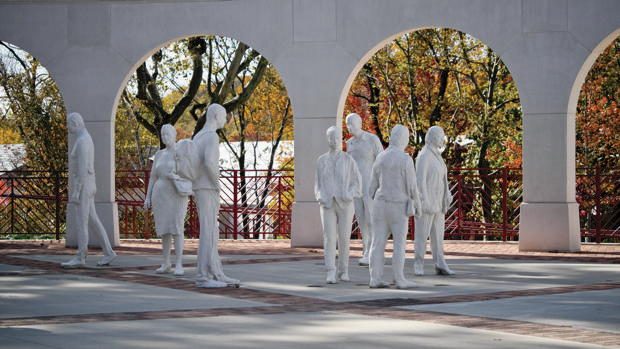
Rena Segal flicks on the overhead lights as she leads a visitor through the 10 rooms in a converted chicken coop that her father, the late painter and sculptor George Segal, used as his studio. Around every corner of the connected coops stand the iconic, lifelike human sculptures Segal created here.
Located at the end of a rural road in Middlesex County, the labyrinthine studio sits alongside the modest Segal family home, where the artist’s wife, Helen, lived until her death last spring. Segal died in 2000; he would have turned 90 on November 26.
Why the chicken coops? “Dad tried his hand at poultry farming,” explains Rena, “but his love of art took over, and in the early 1960s he began painting and sculpting full-time.”
Segal’s method was unique. “Dad dipped surgical bandages into warm water and plaster, then covered his live models from head to toe in the dripping substance resembling cake batter,” says Rena. Segal’s models could be famous—such as Israeli diplomat Abba Eban and Norris Mailer, wife of novelist Norman Mailer—or simply friends, neighbors and family.
Even Rena served as a model. She describes how her father covered her face in Nivea skin cream and her hair in Crisco before applying the plaster bandages. She wore old clothes that could be discarded after the dry plaster was pulled away in sections. The plaster mold became the original from which a limited number of copies were made in bronze.
Segal reveled in capturing his subjects in everyday poses—waiting for a bus, sitting on a diner stool or park bench, lying on a bed. The Breadline, commissioned by Seward Johnson for Grounds for Sculpture in Trenton, depicts five Depression-era men (including Segal himself) standing in line for food. “He could see the ordinary and make it extraordinary,” says Rena.
One of Segal’s works, Woman Painting Her Toenails, greets visitors at the entrance to the George Segal Gallery at Montclair State University; seven figures that comprise the work Street Crossing—one of his best-known pieces—stand outside MSU’s College Hall.
To mark Segal’s 90th birthday, the gallery has educational programming about his life and work planned for late November. Details were unavailable at press time. Additionally, two 1977 pastels and three etchings from Segal’s 1975 work Blue Jean Series from the gallery’s permanent collection are on display now through December 20.
